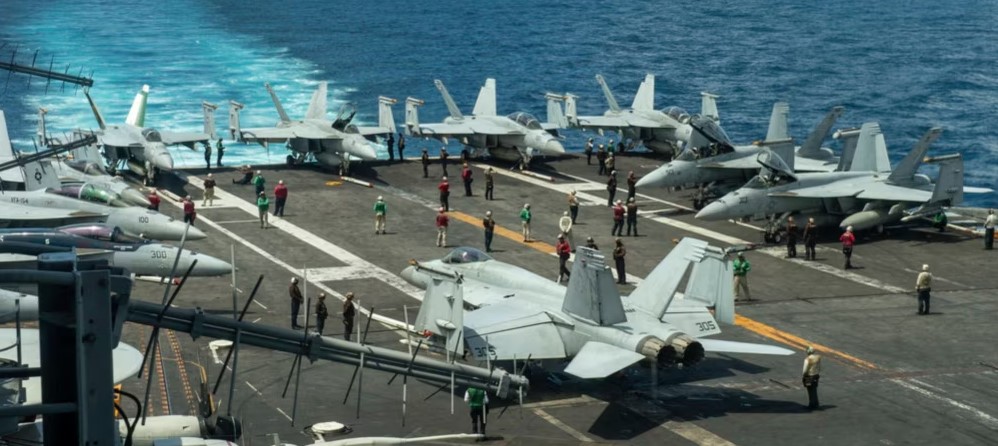WASHINGTON: U.S. warships and fighter jets are headed to the Middle East and nearby areas to bolster American defenses in support of Israel, as both countries brace for a possible military strike by Iran.
U.S. Defense Secretary Lloyd Austin late Friday signed orders to move the additional assets and capabilities to the Middle East and parts of Europe, following pledges by Tehran and its proxies to take revenge for the killing this past week of a top Hezbollah commander in Lebanon and of the Hamas terror group’s political leader on Iranian soil.
The U.S. moves include sending the USS Abraham Lincoln aircraft carrier strike group to the Middle East, along with naval cruisers and destroyers capable of shooting down ballistic missiles.
In addition, the U.S. is sending an additional fighter squadron to the region and is taking steps to allow for the deployment of land-based missile defense capabilities.
The Pentagon did not say when the various ships and planes will be in place, but in a statement Friday it described the moves as necessary to “mitigate the possibility of regional escalation by Iran or Iran’s partners and proxies.”
The statement also said the movement of more military capabilities to the region aims “to improve U.S. force protection, to increase support for the defense of Israel, and to ensure the United States is prepared to respond to various contingencies.”
The new orders came just hours after Austin pledged additional support to Israel during a call with Israeli Defense Minister Yoav Gallant.
“The secretary reiterated ironclad support for Israel’s security and informed the minister of additional measures to include ongoing and future defensive force posture changes that the department will take to support the defense of Israel,” Pentagon spokesperson Sabrina Singh said during a briefing.
The Pentagon’s support for Israel since the October 7 Hamas terror attack “should leave Iran, Lebanese Hezbollah and other Iranian-backed terrorist groups with no doubt about U.S. resolve,” she said.
Tensions in the region have escalated significantly in the past week, following an Israeli strike in Lebanon that killed Fouad Shukur, Hezbollah’s top military commander, and the subsequent assassination of Hamas political leader Ismail Haniyeh, who was in Tehran to celebrate the inauguration of Iran’s new president.
Israel has not publicly claimed responsibility for Haniyeh’s death, but Iran’s supreme leader, Ayatollah Ali Khamenei, put the onus on Israel and called for retribution.
“The criminal, terrorist Zionist regime martyred our dear guest in our territory and has caused our grief, but it has also prepared the ground for a severe punishment,” Khamenei posted on the X social media platform.
“It is our duty to take revenge,” he added in a separate post.
Iranian officials said Thursday they planned to meet with representatives from Iran’s key proxies — including Hamas, Hezbollah, Yemen’s Houthis, and militias in Iraq and Syria — to plan their next steps.
“How Iran and the resistance front will respond is currently being reviewed,” said Major General Mohammad Bagheri, Iran’s armed forces chief, speaking on Iranian state TV.
“This will certainly happen, and the Zionist regime [Israel] will undoubtedly regret it,” he added.
But U.S. officials, seeking to prevent the tensions from exploding into a regional war, have repeatedly signaled that Washington would not leave Israel undefended.
During a call Thursday between U.S. President Joe Biden and Israeli Prime Minister Benjamin Netanyahu, Biden “discussed efforts to support Israel’s defense against threats, including against ballistic missiles and drones, to include new defensive U.S. military deployments,” according to the U.S. readout.
U.S. defense officials Friday likewise emphasized Israel would not stand alone in the face of Iranian aggression.
“We will stand with Israel in their self-defense,” said Singh.
“These are defensive capabilities,” Singh added. “All of our capabilities that we have there in the region are defensive and to send a message of deterrence.”
Besides the additional ships and warplanes headed to the Middle East, the Pentagon has a U.S. Marine Corps amphibious ready group with some 4,000 troops in the region.
The USS Theodore Roosevelt carrier strike group is also in the Middle East but is expected to leave once the USS Abraham Lincoln aircraft carrier strike group arrives.
This would not be the first time the U.S. has enhanced its defensive capabilities to help shield Israel from an Iranian attack.
This past April, the U.S. moved naval destroyers and other military assets into the region while coordinating with Britain, Jordan, Saudi Arabia and other allies in the Middle East to thwart a massive drone and missile barrage by Iran.
At the time, one U.S. official called the effort an “incredible military achievement.”
Whether the U.S. will be able to rely on a similar coalition to deter a second Iranian attack on Israel, however, is unclear.
Whether Iran and its proxies would attempt another aerial attack on Israel, after an estimated 99% of the missiles and drones that they launched in April failed to hit a target, is also unclear.
“Iran is currently in the process of making a difficult decision on how to respond to the targeting killing of Hamas leader Ismail Haniyeh in Tehran,” said Robert Murrett, a retired U.S. vice admiral and deputy director of the Institute for Security Policy and Law at Syracuse University.
“Iran will likely carefully calibrate its response to the Israelis,” Murrett told VOA via email. “They [the Iranians] are fully aware of the regional implications of any direct or indirect attack on Israel with or without surrogates.”
In the meantime, the Pentagon insisted Friday that a further escalation between Iran and Israel “is not inevitable.”
“We do believe there is an off-ramp here, and that is that [Gaza] cease-fire deal,” between Israel and Hamas,” Singh said.
VOA









Comment